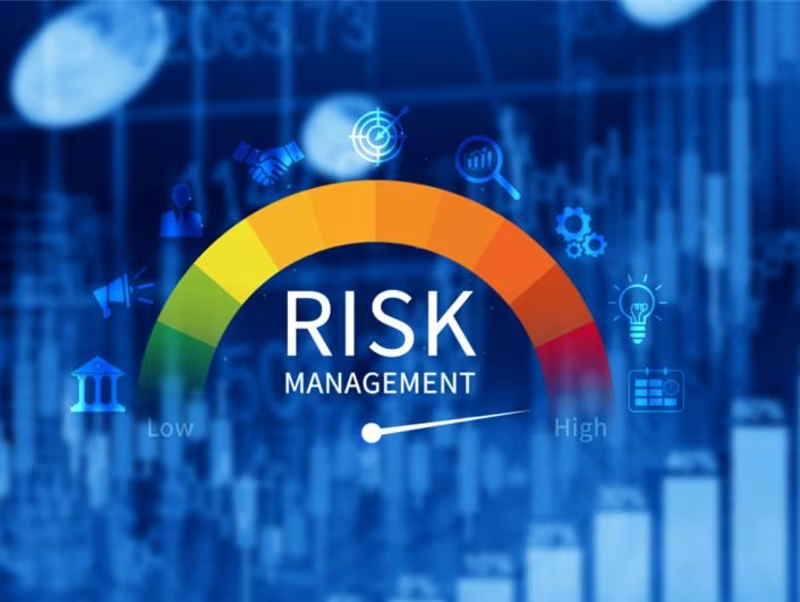Resource / Online Journal
Essential Strategies for Risk Management in Financial Institutions
Learn top cybersecurity risks and strategies to mitigate emerging threats, AI-driven fraud, ransomware, and supply chain risks in Financial Institutions.
Published on Oct 27, 2025

The financial sector is undergoing a profound digital transformation, driven by cloud adoption, open banking initiatives, and the integration of fintech solutions. While these innovations enhance customer experience and operational efficiency, they also introduce unprecedented cybersecurity challenges.
Attack surfaces have multiplied, and adversaries are leveraging advanced tactics, such as AI-driven fraud, deepfake social engineering, and supply chain compromises, to exploit systemic vulnerabilities. A single breach can trigger cascading consequences: regulatory penalties, reputational damage, liquidity stress, and even systemic risk to markets.
Top Emerging Cybersecurity Risks in Financial Institutions
Financial institutions face a rapidly evolving threat landscape shaped by advanced technologies and complex interdependencies. Key emerging risks include:
AI-Powered Attacks and Deepfake Fraud
Financial institutions report surging attacks; attackers are leveraging artificial intelligence to automate phishing and business email compromise (BEC) and create convincing deepfake audio/video for social engineering.
Supply Chain and Third-Party Vulnerabilities
Incidents like SolarWinds underscore how compromised vendors can infiltrate core banking systems. With fintech partnerships and cloud adoption accelerating, third-party risk management is now a regulatory priority.
Ransomware-as-a-Service and Insider Threats
Ransomware groups increasingly target financial data and operational continuity, while insider misuse, whether malicious or accidental, remains a persistent challenge.
Cloud Security and Credential Abuse
Misconfigured cloud environments and stolen credentials sold on the dark web expose institutions to large-scale breaches, as seen in the Capital One case.
Quantum Computing and Cryptographic Risk
Though still emerging, quantum computing poses a long-term threat to current encryption standards. Institutions must begin planning for quantum-resistant cryptography to protect sensitive data.
Regulatory and Compliance Pressures
Frameworks like DORA and SEC disclosure rules demand robust cyber resilience, incident reporting, and governance, making compliance risk a top concern alongside technical threats.
Financial Risk Management Strategies
Regular Cyber Risk Assessments
A robust risk management process begins with continuous risk identification. Financial institutions should conduct comprehensive cyber risk assessments using frameworks like NIST CSF 2.0 and FFIEC tools (Cybersecurity Assessment Tool, Cyber Resilience Review). These assessments help identify potential risks, benchmark governance, and evaluate risk exposure across supply chains and critical systems. Reviews should occur quarterly and before major technology changes to address emerging risks and maintain compliance with financial institution regulations.
Layered Security Architecture
To mitigate operational risk and financial risk, institutions must adopt a multi-layered defense strategy. Deploy next-generation firewalls and intrusion detection/prevention systems, combined with strong encryption for data at rest and in transit. Embrace crypto-agility and begin transitioning to post-quantum cryptographic standards (ML-KEM, ML-DSA, SLH-DSA) to counter future threats like “harvest-now, decrypt-later.” This approach reduces potential losses from advanced attacks and strengthens resilience against market risk and systemic failures.
Identity and Access Management (IAM)
IAM is critical for managing risk in digital ecosystems. Enforce multi-factor authentication (MFA) across all critical systems, conduct continuous access reviews, and apply behavioral analytics to detect anomalies. For open banking APIs, implement FAPI 2.0 security profiles with sender-constrained tokens and proof-of-possession mechanisms to secure consent-driven transactions and prevent unauthorized data exposure. These controls help prevent data breaches, reduce credit risk, and support compliance with new regulations.
Endpoint Security Enhancement
Endpoints from ATMs and kiosks to mobile devices, pose significant operational risk and can lead to bank failures if compromised. Deploy advanced EDR/XDR solutions that provide autonomous threat detection, remediation, and rollback capabilities. Validate these controls against frameworks like MITRE ATT&CK to ensure resilience against real-world adversary tactics. This proactive stance helps risk teams mitigate potential dangers and maintain operational continuity across financial markets.
Strategies for Risk Management in Financial Institutions
Advanced & Emerging Techniques
Zero Trust Architecture (ZTA): Enforce “never trust, always verify” with policy engines/PEPs; restrict per‑session access, monitor posture, and log continuously.
API Security for Open Banking: Align OAuth/OIDC with FAPI 2.0; test against the formal attacker model and conformance suites to reduce fraud in high‑risk transactions.
AI & ML for Detection/Response: Deploy model‑driven anomaly detection; tune for deepfake indicators (voice/video inconsistencies, device posture anomalies); and automate incident contain/notify workflows.
Quantum‑resistant encryption: Inventory cryptographic dependencies, prioritize long‑lived data/transactions, and pilot NIST PQC transitions in TLS and code‑signing.
Organizational & Cultural Measures
Security awareness & phishing drills: Simulate social engineering and deepfake scenarios; measure click‑through and report rates to adjust training.
Vendor risk management: Apply OCC/FFIEC expectations, risk‑based due diligence, contract clauses (notification, audit, subcontracting), and continuous monitoring, and maintain a register of critical ICT providers.
Incident response & exercises: Tabletop ransomware and fraudulent‑payment scenarios; validate escalation within 36‑hour notification rules and SEC 8‑K materiality workflows.
Actionable Checklist (for CISOs & IAM leads)
- Map risk appetite to CSF 2.0 outcomes; maintain a cyber risk register integrated with ERM.
- Deploy ZTA pilots (privileged access, crown‑jewel apps); enforce least privilege and session‑based authorization.
- Harden cloud IAM (block SSRF to metadata, IMDSv2, and role scoping); run periodic breach simulations based on Capital One TTPs.
- Implement FAPI 2.0 for APIs; run attacker‑model testing before production.
- Start a PQC migration plan; prioritize data with long confidentiality lifetimes.
- Formalize vendor oversight per DORA/OCC; maintain registers and subcontracting controls.
- Establish SEC‑ready disclosure controls and materiality analysis procedures.
Conclusion
As digital transformation accelerates, financial institutions face converging operational, market, and cyber risks that demand a proactive, multi-layered approach. Integrating Zero Trust principles, post-quantum cryptography, and AI-driven detection, alongside strong vendor risk management and incident response, helps mitigate emerging threats and maintain resilience.
Yet technology alone is insufficient. Success requires a security-first culture, regulatory compliance, and strategic partnerships. Partner with cybersecurity solution provider TechDemocracy to secure your company from advanced threats with 24/7 SOC support, ensuring protection, continuity, and confidence in the future of finance.
Recommended articles


Effective Strategies in Banking and Risk Management for Success
Take Your Identity Strategy
to the Next Level
Strengthen your organization's digital identity for a secure and worry-free tomorrow. Kickstart the journey with a complimentary consultation to explore personalized solutions.